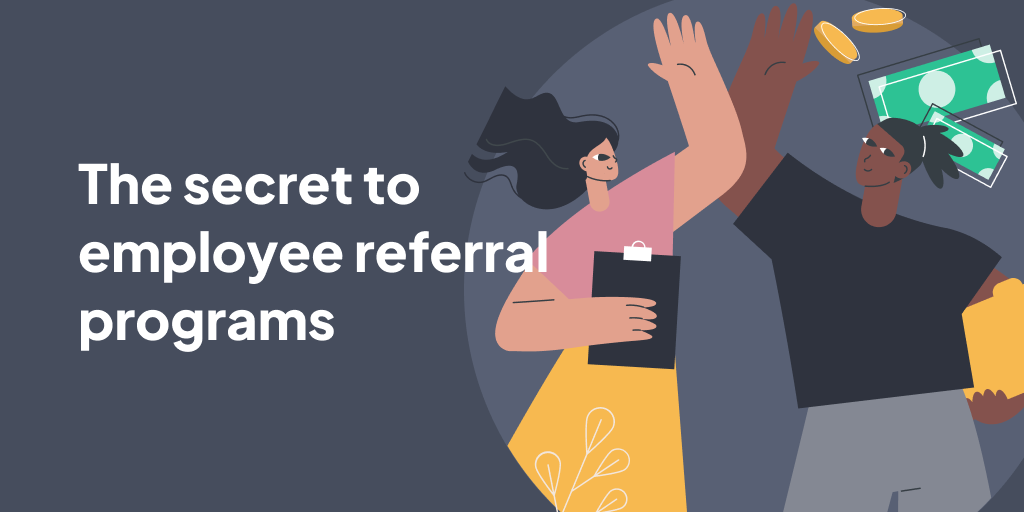Employee referral programs are a powerful tool in the arsenal of modern recruitment strategies. They leverage your existing workforce's networks to bring in top-notch talent. However, the success of such programs is not guaranteed. Several factors can hinder their effectiveness.
What is an employee referral?
Before jumping into specific tips for improving your referral program, let’s level set on how we define what is an employee referral. An employee referral when current employees recommend potential candidates for a job opening within your organization. These referrals can be informal, like through a simple text message, a part of a formal referral program.
Employee referrals often lead to successful hires, as employees are likely to refer individuals they believe would be a good fit for the role, promoting a sense of trust and camaraderie within the workforce.
Now let's take a look at why your employee referral program might be underperforming, and explore strategies to overcome these challenges.
-
Uninteresting Incentives
Asking employees to refer a friend or family member may seem like a small request, but their reputation is on the line. If their referral doesn't get hired or is not qualified, it could pose a problem for them. The best way to overcome this is to offer adequate incentives for successful referrals.
Potential Solutions
- Conduct a survey among your employees to gauge their satisfaction with the current incentives.
- Offer a range of incentive options, such as an extra day off, a gift card, or even a charitable donation in their name.
- Review the survey data and adjust your incentives to align better with what motivates your employees.
Effective incentives motivate employees to actively participate in the referral program and bring in high-quality candidates.
-
Overcomplexity
You may have appealing incentives, but if your program is overly complex, it may discourage employee participation. Complicated processes, lengthy forms, and excessive documentation requirements can be major turn-offs.
Potential Solutions
- Streamline the referral process by reducing the number of steps and questions.
- Implement automated tools and systems to minimize manual data entry.
- Ensure that the program is mobile-friendly, allowing employees to refer candidates with ease.
Simplifying the process makes it more accessible and user-friendly, encouraging more employees to engage in the program.
-
Underpromotion
Even if you initially made a significant effort to promote your referral program, it's easy to let it fade into the background over time. Lack of ongoing promotion can result in reduced employee awareness and participation.
Potential Solutions
- Promote your referral program consistently and across various communication channels. This can include regular mentions in the company newsletter, adding it to your email signatures, or displaying physical signs around the office.
- Include information about the referral program in job descriptions to attract potential candidates.
- Reinforce the program during the onboarding process to ensure that new hires are aware of its existence and benefits.
Continuous and widespread promotion keeps the employee referral program top-of-mind for your team.
-
It's Stale
Effective referral programs are dynamic initiatives. If ignored or left on autopilot, they will lose inertia. Regular updates and revisions are necessary to keep them fresh and effective.
Potential Solutions
- Schedule periodic reviews of your program to identify areas for improvement.
- Solicit feedback from employees about their experiences with the program and their suggestions for enhancements.
- Implement changes based on feedback and evolving company needs.
A dynamic referral program that evolves with your organization will continue to deliver results over time.
-
Lack of Recognition
Employees thrive on recognition and appreciation for their efforts. If your referral program doesn't acknowledge and reward employees for their contributions, it can lead to decreased enthusiasm.
Potential Solutions
- Implement a recognition and rewards system that publicly acknowledges employees who make successful referrals.
- Consider creating a leaderboard or recognition wall to showcase top referrers.
- Host regular recognition events or ceremonies to celebrate employees' contributions.
Recognizing and rewarding employees for their referrals not only motivates them but also reinforces a culture of employee engagement.
-
Misalignment with Company Culture
If your referral program doesn't align with your company's culture and values, employees may be less inclined to participate. It's essential to ensure that the program reflects your organization's mission and vision.
Potential Solutions
- Review your program's messaging and branding to ensure alignment with your company's culture.
- Highlight how employee referrals contribute to the company's growth and success during program promotion.
- Encourage employees to share their positive experiences within the company as part of the referral process.
Aligning the program with your culture not only boosts participation but also reinforces your company's identity.
-
Lack of Tracking and Feedback
Without proper tracking and feedback mechanisms, you may not have a clear picture of your program's performance. This can hinder your ability to make data-driven improvements.
Potential Solutions
- Implement a robust tracking system to monitor the entire referral process, from initial referral to hire.
- Collect feedback from employees and candidates about their experiences with the program.
- Analyze the data to identify bottlenecks, areas for improvement, and successful strategies.
Regularly tracking and reviewing program data allows you to make informed decisions and continuously enhance your employee referral program.
In conclusion, employee referral programs are a valuable asset in the quest to attract and retain top talent. However, they require careful planning, execution, and ongoing optimization to be truly effective.
By addressing these issues and implementing suggested fixes, you can breathe new life into your employee referral program and harness the power of your workforce's networks to bring in exceptional talent.
Remember that a well-executed referral program not only reduces hiring costs but also fosters employee engagement and strengthens your organization's competitive edge in the job market. Take action to revitalize your referral program and watch your talent pipeline flourish.





